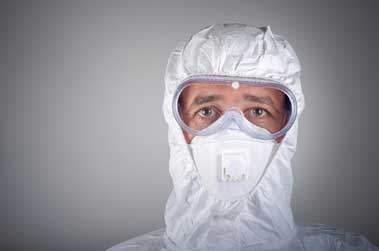Ce nouveau cours d’anglais, élaboré par Virginia Allum, auteur et consultante EMP (English for Medical Purposes) traite des maladies impliquées dans les isolements. Les corrigés des exercices sont à retrouver en PDF en bas de page.
N'hésitez pas à vous servir du dictionnaire en ligne Wordreference. Vous trouverez à la fin de cet article les corrections des exercices qui vous sont proposés téléchargeables au format pdf.
Activity 1
Match the French term with the correct English translation.
| 1. brûlures infectées | a) pertussis or whooping cough |
| 2. diphtérie | b) tuberculosis |
| 3. entérocolite | c) bone marrow transplant |
| 4. Staphylocoque doré | d) scarlet fever |
| 5. rubéole | e) infected diarrhoea |
| 6. CMV congénitaux | f) rabies |
| 7. bacilles pyocyanique | g) aplastic patient |
| 8. entérobactéries | h) infected burns |
| 9. coqueluche | i) organ transplant |
| 10. charbon | j) meningococcal meningitis |
| 11. rage | k) diphtheria |
| 12. tuberculose | l) congenital cytomegalovirus |
| 13. vaccine généralisée | m) pseudomonas |
| 14. scarlatine | n) enterocolitis |
| 15. greffes organe | o) generalised vaccinia |
| 16. greffes de moelle osseuse | p) golden staph, staphylococcus aureus |
| 17. malade aplasique | q) rubella |
| 18. rougeole | r) anthrax |
| 19. diarrhées infectieuses | s) enterobacteria |
| 20. méningites à méningocoques | t) measles |
Activity 2
Complete the sentences using the terms from the list in Activity 1.
- ___________________ is a serious bacterial infection of the thin lining that surrounds the brain and spinal cord.
- ___________________ is also called golden staph; a common bacterium which lives on the skin and in the nose.
- ___________________ is a highly contagious disease which causes a red, flat rash.
- ___________________ is a virus which is usually transmitted through the bite of an infected dog, fox or bat.
- ___________________ causes a thick covering in the back of the throat and can lead to difficulty breathing.
- ___________________ gets its name from the noise made after a long coughing fit.
- Skin ___________________ is often caused by infected spores on animals entering the body through a cut.
- ___________________ is a skin reaction to the smallpox vaccine.
- ___________________ is a type of herpes infection which can cause hearing loss in babies.
- Patients are nursed in isolation rooms after an ___________________, because they are susceptible to infections.
Activity 3
Watch the video and answer the questions.
The video can be found at www.youtube.com
- Why is the patient in the isolation room?
- Can the patient’s daughter visit her father?
- What must you do first, before entering an isolation room?
- What must you wear, before entering an isolation room?
- What must the patient use, while he is in the isolation room?
Activity 4
What does the nurse say? Match the beginnings and endings of the sentences you hear.
| We are trying to stop the infection | before you enter the room. |
| It’s not dangerous, but | put them in the clinical waste bin. |
| The first thing is to clean your hands, | spreading to other patients. |
| You also have to | with the alcohol gel at the end of the bed. |
| Put on some | we have to be careful. |
| The final thing is to put on | put on a disposable apron. |
| Take off the gloves, mask and apron and | single use gloves. |
| Then clean your hands | a disposable mask. |
Téléchargez les corrections au format PDF
Virginia ALLUM Author and Consultant in English for Medical Purposes http://www.ifsiprepanglais.com



REFONTE DE LA FORMATION
L'idée d'un tronc commun en master hérisse les infirmiers spécialisés
ÉTUDES
D’infirmier à médecin : pourquoi et comment ils ont franchi le pas
VIE ÉTUDIANTE
FNESI'GAME : l'appli qui aide les étudiants infirmiers à réviser
PRÉVENTION
Des ateliers pour préserver la santé des étudiants en santé